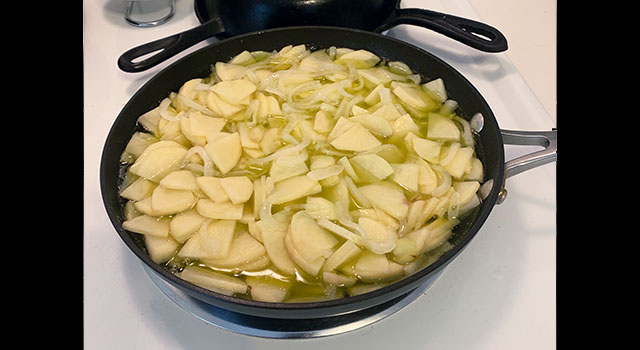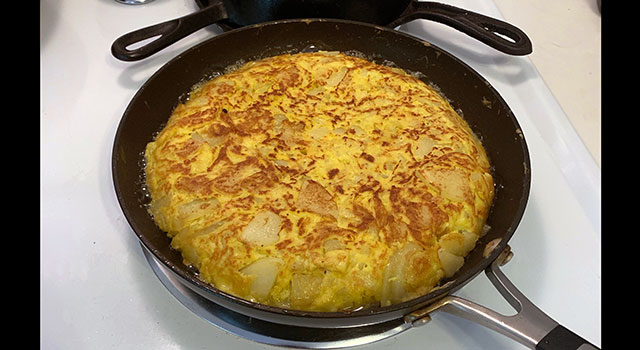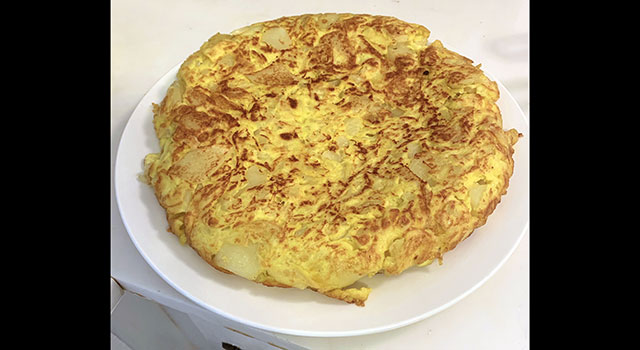How (Not) to Make a Proper Tortilla Española

What you leave out means as much as what you put in …
There are three sides in a triangle. Four gospels in the New Testament. And five ingredients in a tortilla española.
Eggs (5), potatoes (3), onions (2), olive oil and salt. Nothing more, nothing less. Así se hace, so it is done.
Back in the 1980s I lived in Madrid. Rented a room from a woman whose father had gone missing back in the Spanish Civil War, and her Cuban refugee husband. Meals included.
Every morning, while Rolando was down at the accounting firm and I was at the university, Lola would do the rounds of the markets on the nearby blocks, searching out lo más fresco — fish, vegetables, chorizo, daily baked bread.

Lola didn’t visit the supermercado, unless at need. I had to buy my own cornflakes. She didn’t mind me keeping the box in her kitchen, but Lola didn’t hold with serving Rolando “esas cosas”, those things.
Come siesta time, Rolando would catch the Metro northbound and I’d take a hike up the hill. Dinner started with soup or salad. Then the main plate, vegetables with fish or meat. Some fruit finished off the meal.
Everything simple. Everything fresh. Even an ensalada of lettuce, onion, and tomato dressed with olive oil, a squeeze of lemon, and a generous pinch from the salt box was like a bowl straight from the garden of Eden.
The secret to comida casera, Spanish home cooking, was to let the ingredients speak for themselves. And it didn’t get any simpler, or any better, than tortilla española, what we call Spanish omelet. Hot from the skillet, or sliced thin for a tapa alongside a cold draft beer at the pub, or served inside a buttered tranch of hard bread as a bocadillo at the basement café counter of the university facultad, tortilla was a sweet and delicate yet earthy treat for the senses.
I’ll show you how to make it, the way I was taught. But what you’ve got to promise me is, don’t mess with it. Don’t “add” to it. No spinach, no garlic, no chorizo, no browning the potatoes or carmelizing the onions, none of that. Or if you do, don’t call it a tortilla española.
Americans tend to think of potatoes as vehicles. Carriers for other flavors. We deep-fry them sliced, toss them in “Cajun” spices and dunk them in ketchup. We bake them then slather on the butter, sour cream, bacon, and chives. We casserole them with peas, carrots, sharp cheddar cheese, and bread crumbs.
For a tortilla española, you’ll simmer thinly sliced potatoes in olive oil to evoke their own natural flavor and sweetness. Think poaching, not frying. Ordinarily, you’d use a “light” olive oil for pan cooking. It has a milder taste and a higher smoke point. But for tortilla the Spanish way, you want a robust extra virgin oil so you can distinguish the potato, onion, olive, and egg on your palate.
These are earthy but surprisingly fragile flavors. Add anything else, and you’ll overwhelm at least one of them and throw everything off balance.
With that in mind, here’s the essential recipe …
Peel 3 medium-sized potatoes and cut them in half lengthwise. Cut each half again and make thin quarter-round slices.
 Just cover the potatoes with olive oil in a 10″ skillet and bring to a low simmer. Then halve two medium-sized onions from end to end, peel, and slice thinly.
Just cover the potatoes with olive oil in a 10″ skillet and bring to a low simmer. Then halve two medium-sized onions from end to end, peel, and slice thinly.

Add the onions to the skillet and gently mix with the potatoes. Let cook at a bare simmer for about another 15 minutes, around 20 minutes total for the potatoes.

Lightly beat five farm-fresh eggs in a large bowl with a generous dash of salt and set aside.
Transfer the vegetables from the pan into a colander set over a container to drain off the oil, leaving enough oil in the pan to cook the tortilla. (Spanish households often save this oil to reuse, since it has not been brought to a high heat.)

Now mix the vegetables in with the beaten eggs and spoon the mixture around a bit so the eggs begin to set slightly. Then pour the mixture back into the pan to finish. Spoon it around a little more with a spatula to get even cooking until it’s not liquid. Use the spatula to mind the edges as it sets through.
Once it’s set, flip the tortilla by covering the skillet with a slightly larger plate and flipping the whole thing over. Then flip the pan rightside-up again and return to the burner. Slide the tortilla from the plate back into the pan.

Once the other side is done, which you can check with the spatula, slide the finished tortilla back onto the plate.

The edges on this one came out kind of raggedy. I still haven’t mastered that part of it. But once it’s sliced, who cares? And when I take a bite, the flavor brings back so many memories — mornings at the facultad with strong black coffee, picnics in the city park, tapeando at the bars late into the Madrid night.
Which, I suppose, is so much of the magic of food.
Thanks again, Lola. Wherever you may be.
Read every story from Paul Thomas Zenki (and thousands of other writers on Medium).
Paul Thomas Zenki is an essayist, ghostwriter, copywriter, marketer, songwriter, and consultant living in Athens, GA.